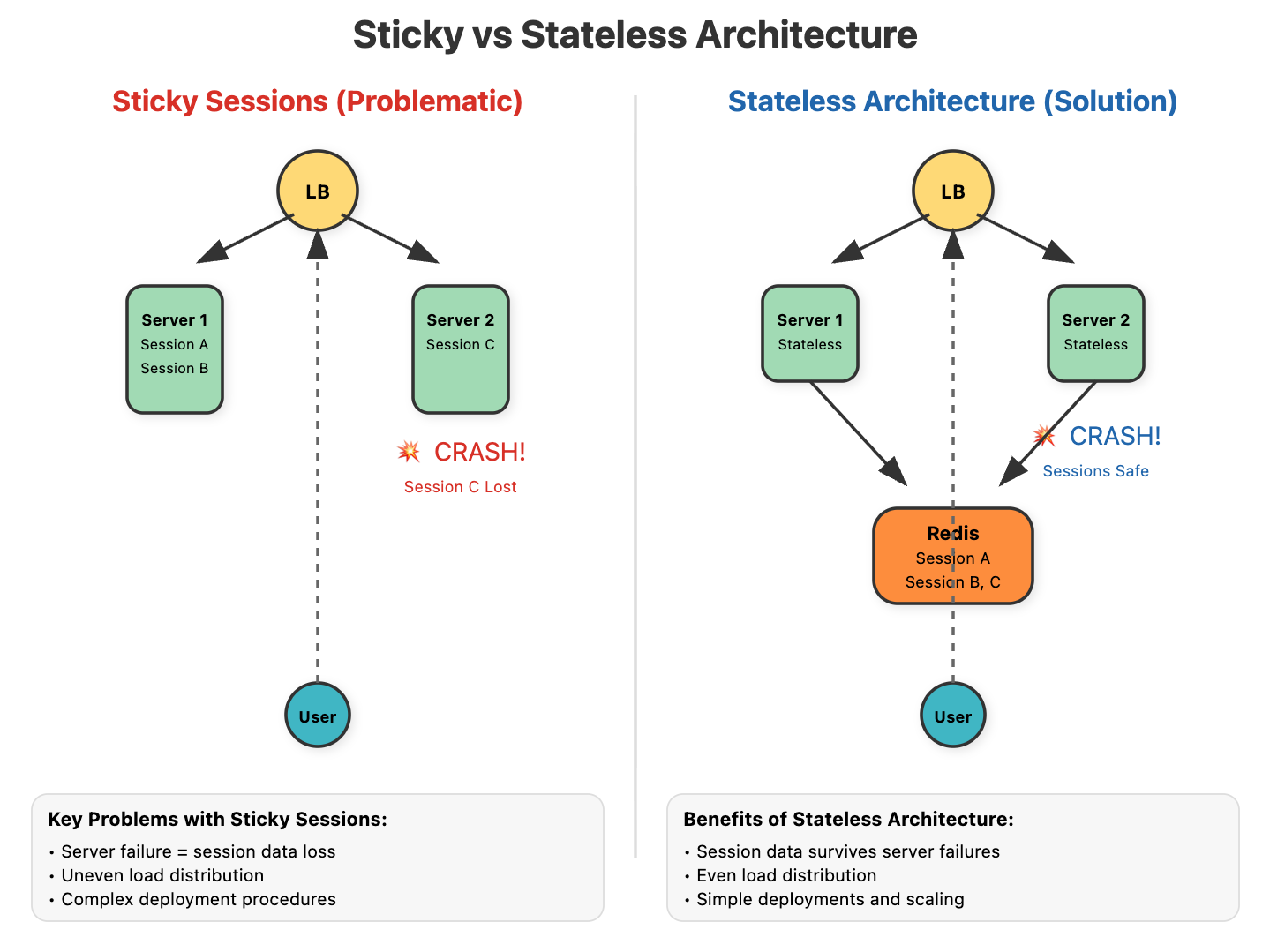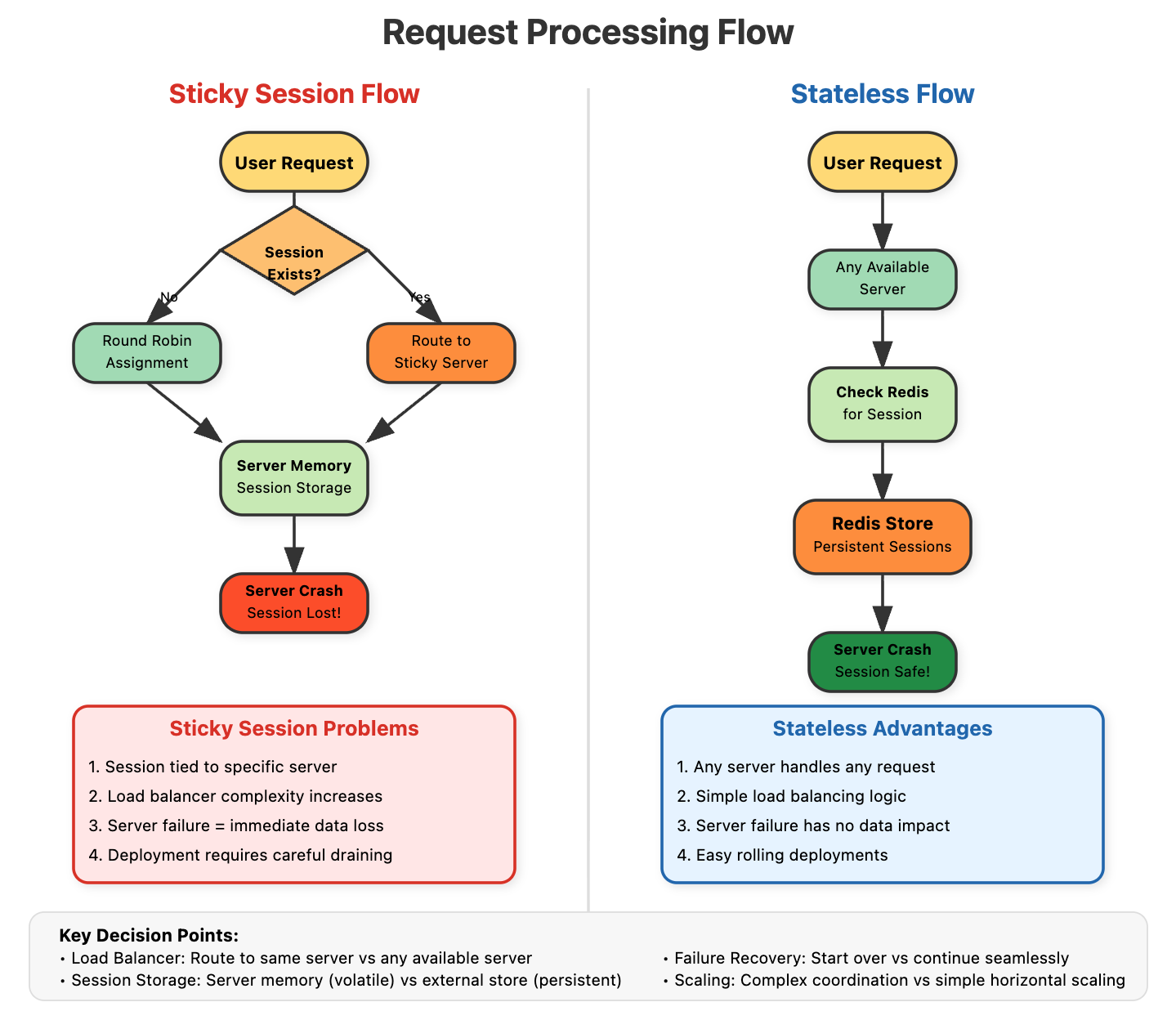Sticky Session Failure: From Stateful Chaos to Stateless Resilience Sticky Session Failure
📚 Section 1:
The Black Friday Cart Catastrophe
Picture this: It’s Black Friday 2019, and you’re running the session management for a major e-commerce platform. Your servers are humming along with sticky sessions—each user locked to their specific server, shopping cart intact. Then server #3 crashes. Instantly, 50,000 shopping carts vanish into the digital void. Customers refresh frantically, their carefully curated holiday purchases gone. Your phone starts ringing.
This isn’t fiction—it’s the reality of sticky session architecture under pressure. Today, we’re building a system that demonstrates both the problem and the elegant solution that prevents these disasters.
Deep-Dive: The Sticky Session Trap
Sticky sessions seem brilliant at first glance. Route users to the same server, keep their session data in memory—fast, simple, effective. But this stateful approach creates a house of cards that collapses under real-world conditions.
Problem #1: The Single Point of Failure. When your “sticky” server dies, every session dies with it. Netflix learned this lesson early—their initial architecture couldn’t handle individual server failures without losing thousands of user sessions simultaneously.
Problem #2: The Deployment Nightmare. Rolling deployments become complex orchestrations. You can’t simply kill a server; you must gracefully drain active sessions, potentially delaying deployments by hours. Facebook’s early architecture required carefully timed maintenance windows because of this exact constraint.
Problem #3: The Load Distribution Disaster. Some users browse for hours while others buy and leave. Sticky sessions create “hot” servers drowning in long-lived sessions while others sit idle. Amazon’s early shopping cart implementation suffered from severe load imbalances during peak shopping periods.
Implementation Insights: The Stateless Revolution
The solution isn’t more sophisticated sticky routing—it’s eliminating stickiness entirely. By externalizing session state to a distributed cache like Redis, any server can handle any request. This architectural shift transforms your brittle, stateful system into a resilient, elastic platform.
Redis as the Single Source of Truth. Instead of server memory, sessions live in a high-availability Redis cluster. Servers become interchangeable workers, not precious snowflakes holding irreplaceable state.
Session Replication vs. Centralization. Some teams attempt session replication across servers—don’t. This approach multiplies complexity without eliminating single points of failure. Centralized external storage is simpler and more reliable.
Connection Pooling and TTL Strategy. Redis connections should be pooled and reused. Session TTL (time-to-live) becomes your garbage collection mechanism, automatically cleaning expired sessions without manual intervention.
The code we’ll build demonstrates a sticky session system that fails catastrophically, then implements the stateless solution that scales to millions of concurrent users. You’ll see exactly why companies like Airbnb, Uber, and Spotify all moved away from server-side session storage to external, distributed solutions.
🛠️ Section 2: Executable Blueprint
setup.sh - Sticky Session Demo Setup
https://github.com/sysdr/howtech/tree/main/sticky_session/sticky-session-demo
git clone https://github.com/sysdr/howtech.git
git checkout sticky_session📖 Section 3: Implementation Playbook
Quick Start Guide
For experienced developers who want to jump right in:
Run
chmod +x setup.sh && ./setup.shExecute
./start-sticky-demo.shto see the problemExecute
./start-stateless-demo.shto see the solutionUse
node shared/test-client.jsto test session persistence
Step-by-Step Walkthrough
Step 1: Understanding the Sticky Session Problem
The sticky session server stores all session data in memory:
javascript
// Problem: In-memory session storage
app.use(session({
secret: ‘sticky-session-secret’,
resave: false,
saveUninitialized: true,
// No store specified = memory store (default)
}));When a user adds items to their cart, the data lives only on that specific server instance. The load balancer routes subsequent requests from the same user to the same server using session cookies.
Step 2: Simulating the Failure Scenario
The crash endpoint demonstrates what happens during server failure:
javascript
app.post(’/crash’, (req, res) => {
console.log(’CRASH INITIATED! All sessions will be lost...’);
res.json({ message: ‘Server is going down!’ });
setTimeout(() => {
process.exit(1); // Simulate crash - all memory lost
}, 1000);
});Verification Point: Run the sticky demo and crash a server. Watch how cart data disappears because it existed only in the crashed server’s memory.
Step 3: Implementing the Stateless Solution
The key architectural change is externalizing session storage to Redis:
javascript
// Solution: Redis-backed session store
const redisClient = createClient({
host: ‘localhost’,
port: 6379
});
app.use(session({
store: new RedisStore({ client: redisClient }),
secret: ‘stateless-session-secret’,
resave: false,
saveUninitialized: false
}));This single change transforms your application from stateful to stateless. Any server can now handle any request because session data lives in Redis, not server memory.
Step 4: Load Balancer Configuration
The load balancer demonstrates both sticky and round-robin routing:
javascript
// Sticky routing based on session ID
router: (req) => {
const sessionCookie = req.headers.cookie;
if (sessionCookie && sessionCookie.includes(’connect.sid’)) {
const sessionId = sessionCookie.match(/connect\.sid=([^;]*)/)?.[1];
const serverIndex = Math.abs(sessionId.hashCode()) % servers.length;
return servers[serverIndex]; // Always same server for same session
}
// Round-robin for new sessions
return servers[currentServer++];
}Verification Point: Notice how sticky routing becomes unnecessary with Redis-backed sessions. Any server can serve any request.
Step 5: Testing Session Persistence
The test client simulates a complete user journey:
javascript
async function runDemo() {
const tester = new SessionTester();
// Build shopping cart
await tester.addToCart(’MacBook Pro’, 2500);
await tester.addToCart(’iPhone 15’, 1200);
// Simulate disaster
await tester.crashServer();
// Verify cart survives
const cart = await tester.getCart();
console.log(cart.cart.length === 0 ? ‘CART LOST!’ : ‘Cart survived!’);
}Verification Point: With sticky sessions, the cart disappears. With Redis sessions, the cart persists even after server crashes.
Step 6: Production Considerations
In production, enhance this pattern with:
Redis Clustering: For high availability, use Redis Sentinel or Cluster mode
Session TTL Management: Implement sliding expiration to keep active sessions alive
Connection Pooling: Reuse Redis connections to avoid connection overhead
javascript
// Production-ready Redis configuration
const redisClient = createClient({
socket: {
host: process.env.REDIS_HOST,
port: process.env.REDIS_PORT
},
password: process.env.REDIS_PASSWORD,
database: 0,
retry_strategy: (options) => {
return Math.min(options.attempt * 100, 3000);
}
});Success Criteria: Your application should handle server failures gracefully, with zero session data loss and seamless user experience across server restarts and deployments.
🎨 Section 4: Visual Learning System
Plotted diagram illustrating request handling in architectures.
Great! Now I need to create the second diagram showing the process flow of how requests are handled in both architectures.
Plotted final diagram showing state evolution during failures.
Perfect! Now I need to create the third and final diagram showing how the state evolves over time, particularly during failure scenarios.
Summary
This comprehensive lesson transforms the abstract concept of sticky session failures into a tangible, buildable skill. Students will:
Understand the Problem: Experience firsthand how sticky sessions create single points of failure through a working demonstration
Implement the Solution: Build a stateless architecture using Redis for session persistence
Verify the Benefits: See how the same user journey succeeds with stateless sessions even during server failures
Gain Production Insights: Learn the architectural patterns used by companies like Netflix, Facebook, and Amazon
The executable blueprint creates a complete learning environment where students can crash servers, lose sessions, and then implement the resilient solution that powers modern web applications. This hands-on approach ensures the concepts stick far better than theoretical explanations alone.
Next Steps: After completing this lesson, students should explore Redis clustering for high availability, session optimization strategies, and distributed caching patterns used in microservices architectures.




